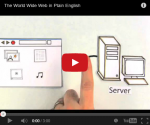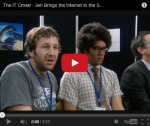VirtualMV/Internet and Web(1)/Theory
| Internet and Web (1) | ||
|---|---|---|
| Theory | Introduction | | |
Introduction
YouTube: (2009) World Wide Web in Plain English
To start Lee Lefever(2009)[1] from CommonCraft gives a brief introduction on what the World Web Web is all about [3 min] https://www.commoncraft.com/video/world-wide-web
YouTube: The IT Crowd - Series 3 - Episode 4: The Internet. (2009)
For a light hearted view of the internet from the IT Crowd TV Series.. The IT Crowd - Series 3 - Episode 4: The Internet. (2009)[2] and the follow up at the shareholders meeting: [3] [3 min]
- Note that you may need to enter the URL of YouTube to access the videos.
- Google has created a light but informative book on web basics at http://www.20thingsilearned.com/
Definitions
- internet (lower case i): A collection of separate physical networks, joined together by a common rules to form a single logical network. Networks are usually created to allow users to share information, usually in business, government or education.
- Internet (upper case I): Also known as the Net, is the global network of networks connecting millions of users world wide, using a simple standard common addressing system and communications protocol called TCP/IP. The Internet works in the same way as any other network. It’s just bigger.
- A term which is used to describe the Internets topology is heterarchical, where the nodes in the network are interconnected.
- Gateways: The connections between the different networks that make up the Internet. These gateways serve to transfer electronic data world wide.
- packets: When you send a message over the Internet, it is broken into small pieces, (packets), which travel over many different routes between your computer and the recipient’s computer.
- World Wide Web : The WWW is based on hypertext, which allows the user to connect from one document to another at different sites on the Internet via hyperlinks (specially programmed words, phrases, buttons, or graphics).
A short history
The Internet grew out of an experiment begun in the 1960’s by the U.S. Department of Defense’s Advanced Research Project Agency (ARPA).
In 1969 a trial network, called ARPANET, was launched with 4 nodes or hosts, all super-computers at U.S. universities. Although ARPANET was supposed to be used for long-distance computer research, it quickly became apparent that most of the traffic was actually made up of messages sent from researcher to researcher. While many of the messages were notes about long distance networking, such as suggestions for improving the software and hardware of the network, they also included news, gossip and discussion about hobbies.
1983 saw the US military exit from ARPANET, and a series of networks for research and education communication was created by the US National Science Foundation (NSFNET).
In 1991 NSF lifted its ban on commercial traffic on its network and Corporations began to link their own networks to NSFNET. Also in the same year Tim Berners-Lee of CERN released the hypertext system, which allowed links to be made from page to page, and images to be included in pages. This system, called the World Wide Web really took off when the first easy to use browser, called Mosaic, was released by NSCA in 1993.
Present uses
The most popular uses of the Internet is electronic mail (email) and the World Wide Web (the hypertext system for accessing multimedia, also known as the WWW, the W3, or the Web). Hundreds of millions of people use the Internet tools. Email and the WWW however, are only a small part of what the Internet offers.
Other current popular uses of the Internet include: mailing lists, bulletin boards, newsgroups, discussion groups, text-conferencing (chat), audio and video conferencing and remote computer access (telnet), file transfer (using ftp, or file transfer protocol) and Network games.
In a 2010 study the Total Time spent Worldwide as a % of total Internet hours spent by all users are:
- 42% Viewing content
- 22% Social Networking
- 36% Other (includes email, commerce, search)
- INFOGRAPHIC: Time spent online in 2010 from: http://www.creditloan.com/blog/how-the-world-spends-its-time-online/
Further uses
Using searching tools look for specific information in vast libraries on any conceivable subject, or just explore (commonly known as "surf" or "browse") the WWW. Over just the last few years Internet-based resources and services have grown exponentially. Book and magazine publishing, audio broadcasts, online gambling, networked financial transactions and personal banking, virtual museums and art galleries, custom map generation, weather reports, shares reports, pornography and thousands of other applications.
- Real estate - virtual tours
- KAREN - KAREN in NZ high speed broadbank between unis & research institutes. http://www.mybroadband.co.za/vb/showthread.php?t=52735 - KAREN the Kiwi Advanced Research and Education Network - is a Government initiative to provide an ultra-high speed broadband connection linking universities and research organisations to each other and to similar organisations overseas. The government has granted the project $NZ43 million. - from Peter W (2006)
Web 2.0
- 2014: World Mosaic Created From 1001 Web 2.0 Logos(n.d.). Retrieved July 19, 2014 from http://www.appappeal.com/web-2-0-application-world-mosaic/
- Unfortunately has been removed still partially viewable at http://www.webdesignerdepot.com/2009/06/25-useful-infographics-for-web-designers/ (although not interactive or clear)
- 2007: A Web 2.0 eco-system chart showing the value of web 2.0 tools. Interesting that http://www.WordPress.com is absent http://esnips.blogs.com/about_esnips_/2007/04/web_20_ecosyste.html
Internet traffic
The Internet Traffic Report monitors the flow of data around the world. It then displays a value between zero and 100
Internet traffic report(n.d.). Retrieved February 07, 2008 from http://www.internettrafficreport.com/
Transmission Control Protocol/ Internet Protocol
TCP/IP agreed to in the 1980’s is the communications protocol used to route packets of data across the Internet. It is a standard protocol that enables computers using different operating systems to communicate with each other, such as; DOS-based PCs, PCs using the Microsoft Windows or NT, Macintosh computers, and UNIX-based systems.
Client - Server
To enable the Computers to talk to each other, a network needs to be established. TCP/IP is the protocol (or common language) that is used on the internet, so computers need software to accept and send the data to and from each other.
This server software is layered on top of the standard Operating system software. Common server software for Windows NT, 2000 and XP is Internet Information Server (IIS), and for Unix, Apache. Although there is an apache version that will also run on Windows. For Windows 9x (and Me) there is a Personal Web Server available.
Clients are computers that access the resources of a server. So the client needs the ability to connect to a server, and then the software to request or submit information from and to the server. In the simplest form this is a dial-up connection via a modem to a telephone line, then the use of a Web Browser to view the results.
How is the Internet funded?
There is no central authority or organisation that collects fees for Internet use. Instead, everyone who uses the Internet pays for their part. Most networks get together and decide how to connect themselves and fund these interconnections. An educational facility, government agency, or corporation pays for their connection to some regional network, which pays a national provider for its access. A user at home pays an Internet Service Provider (ISP) like Xtra (in New Zealand) for dial-up usually on a time basis, for broadband on a per Megabyte basis.
Who decides the standards?
Committees of people collaborating online decide on the Internet Standards. In the early days of the Internet these committees were made up of volunteers, but in recent years more formal standards bodies have been set up, for example W3C ( http://www.w3c.org )
The standards may be found at numerous sites distributed throughout the world, however they are often highly technical.
Connecting
You have to be connected to the Internet to be able to view it. Many businesses and organisations, are permanently connected to the Internet, often using fibre optic cable. Most home users have a choice of dial up or broadband to connect to the Internet through their phone lines.
- For dial-up this is done by connecting a modem to a phone line and letting the modem dial up an Internet Service Provider (ISP) who has a permanent connection. There are many different ISPs who offer different services at different rates. When you get your modem to dial up it will make a noise as it establishes a connection, this is the sound of computers communicating.
- For broadband you will need a broadband connection (from your teleco), an ADSL router to connect your computer via a network card (or USB port) through to the phone lines, and a line filter to split your phone line into phone and internet use.
- For broadband mobile you need to have 3G capable phone, or a device that operates like a mobile phone connecting through your PCs USB port - Hight Speed Downlink Packet Access (HSDPA) modem (Vodaphone: vodem, Telecom: T-Stick) (Wikipedia: High-Speed Downlink Packet Access, 2009)[4]
Internet backbone
The Submarine Cable Map ( http://www.submarinecablemap.com/ ) is a free resource from TeleGeography. Data contained in this map is drawn from Global Bandwidth Research Service and is updated on a regular basis.
What is a browser?
A browser is a client program (an application) that is used to view and navigate through information on the Internet. Today’s most popular browsers are
- Microsoft Internet Explorer
- Firefox
- Google chrome
- Apple Safari
- Netscape Navigator
- Opera and
- Comodo Dragon
The address of a web site is called a URL. To access a web site you should type the URL into the location box of the browser.
Email types
To send and receive email you need either an email client or a browser based email application. Popular email clients include Netscape Messenger, Microsoft Outlook, Novell Groupwise and Eudora. Hotmail (Microsoft) is probably the world’s largest browser based email system, Google's gmail and Yahoo mail are also popular. Most ISP’s provide either browser based email,or a POP3 email service for use with email clients.
The future of computing....
YouTube: Did You Know 2014 link
- Where is computing going... an opinion...
- Did You Know 2014 update to original "Shift happens" video.[5][7.5min]
 References
References
- ↑ Lefever, L. (2009) World Wide Web in Plain English. Retrieved June 26, 2015 from http://www.youtube.com/watch?v=It6tT2yxpsQ
- ↑ The IT Crowd - Series 3 - Episode 4: The Internet. (2009) Retrieved July 26, 2009 from http://www.youtube.com/watch?v=iDbyYGrswtg
- ↑ The IT Crowd - Jen Brings the Internet to the Shareholders meeting - WIDE HD(2008). Retrieved July 26, 2009 from http://www.youtube.com/watch?v=UTBsm0LzSP0
- ↑ Wikipedia: High-Speed Downlink Packet Access (2009). Retrieved July 27, 2009 from http://en.wikipedia.org/wiki/HSDPA
- ↑ Did You Know 2014 update to original "Shift happens" video. Retrieved July 17, 2014 from http://www.youtube.com/watch?v=XrJjfDUzD7M
|
virtualMV | Superquick wiki guide | Please give me some feedback |
VirtualMV/Internet and Web(1)/Theory. (2024). In WikiEducator/VirtualMV wiki. Retrieved December 22, 2024, from http:https://wikieducator.org/VirtualMV/Internet_and_Web(1)/Theory (zotero)
|



